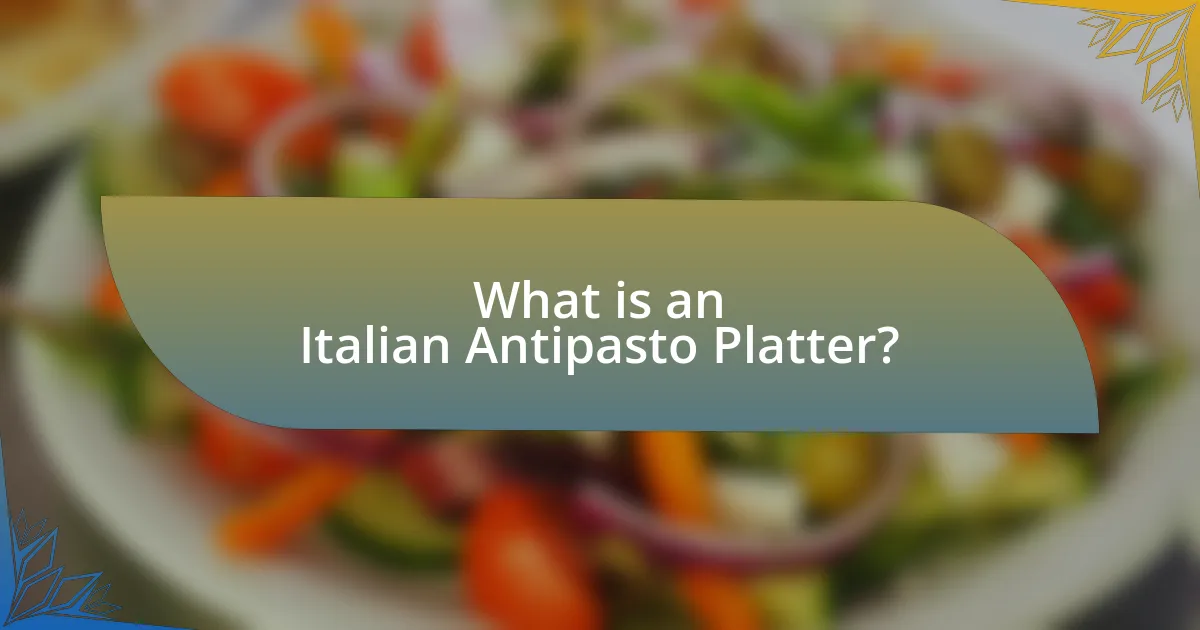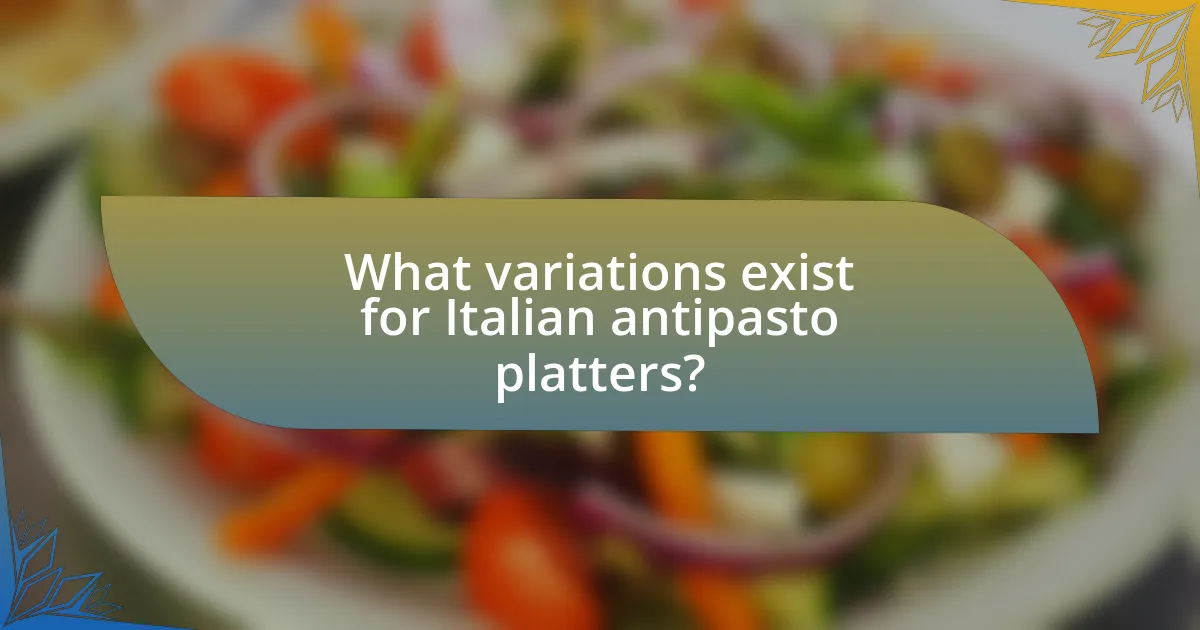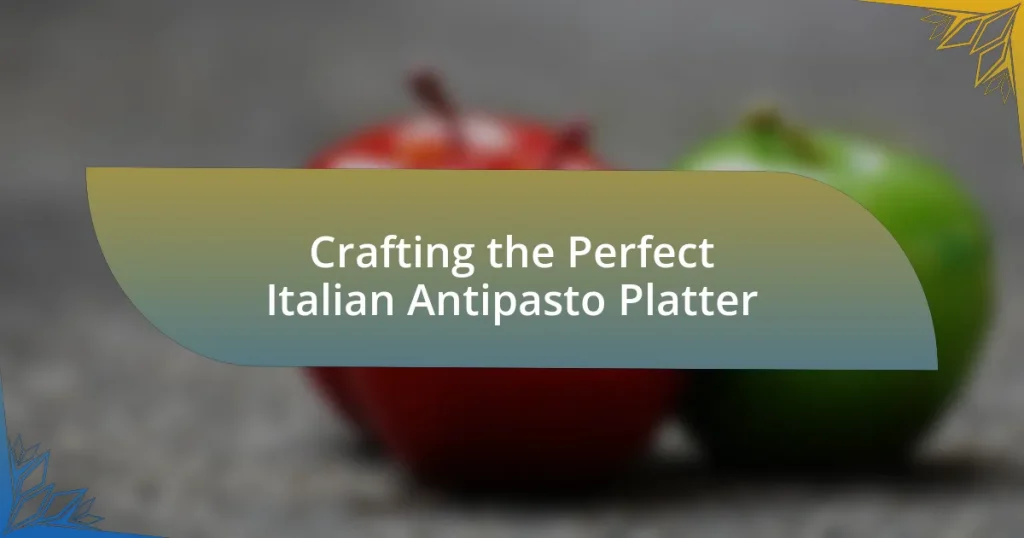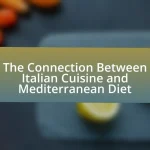An Italian antipasto platter is a traditional appetizer that showcases a variety of cured meats, cheeses, olives, marinated vegetables, and bread, reflecting Italy’s rich culinary heritage. The article explores the origins of antipasto, its historical influences, and how it has evolved over time, highlighting key components such as prosciutto, mozzarella, and marinated vegetables. It also discusses best practices for assembling and presenting the platter, variations across different regions of Italy, and tips for accommodating dietary preferences. Additionally, the article emphasizes the importance of flavor balance and visual appeal in creating an enjoyable antipasto experience.

What is an Italian Antipasto Platter?
An Italian antipasto platter is a traditional appetizer that features a variety of cured meats, cheeses, olives, marinated vegetables, and bread. This platter serves as a flavorful introduction to a meal, showcasing regional ingredients and culinary diversity. Typically, it includes items such as prosciutto, salami, mozzarella, and artichokes, reflecting Italy’s rich gastronomic heritage. The combination of these elements not only enhances the dining experience but also highlights the importance of sharing and communal eating in Italian culture.
How did the tradition of antipasto originate in Italy?
The tradition of antipasto originated in Italy as a precursor to the main meal, serving as an appetizer to stimulate the appetite. Historically, it emerged from the Italian custom of serving a variety of cured meats, cheeses, and vegetables before the main course, reflecting regional ingredients and culinary practices. This practice dates back to ancient Roman times, where the concept of “antipasto” was linked to the idea of enjoying small bites before a larger feast, emphasizing the importance of communal dining and the celebration of local produce.
What historical influences shaped the antipasto platter?
The antipasto platter is shaped by various historical influences, primarily from ancient Roman and Mediterranean culinary traditions. The Romans introduced the concept of serving appetizers before a meal, utilizing ingredients like cured meats, cheeses, olives, and vegetables, which are foundational to modern antipasto. Additionally, the influence of regional Italian ingredients, such as sun-dried tomatoes and artisanal cheeses, reflects the agricultural practices and local flavors that have evolved over centuries. The incorporation of diverse ingredients also stems from trade routes that brought spices and new foods to Italy, further enriching the antipasto experience.
How has antipasto evolved over time?
Antipasto has evolved from its origins as a simple starter in ancient Roman cuisine to a diverse and elaborate assortment of appetizers in modern Italian dining. Initially, antipasto consisted of basic ingredients like olives, cheeses, and cured meats, reflecting the local produce and preservation methods of the time. Over centuries, regional variations emerged, incorporating a wider range of ingredients such as marinated vegetables, seafood, and artisanal breads, influenced by Italy’s rich culinary traditions and globalization. Today, antipasto platters are often artfully arranged and include a variety of flavors and textures, showcasing both traditional and contemporary elements, which highlights the dish’s adaptability and enduring popularity in Italian cuisine.
What are the key components of an Italian antipasto platter?
An Italian antipasto platter typically includes cured meats, cheeses, olives, marinated vegetables, and bread. Cured meats such as prosciutto, salami, and capicola provide savory flavors, while cheeses like mozzarella, provolone, and Parmigiano-Reggiano add richness. Olives, often marinated in herbs and spices, contribute a briny taste, and marinated vegetables like artichokes and roasted peppers offer a tangy contrast. Bread, such as focaccia or ciabatta, serves as a base for enjoying these components. This combination reflects traditional Italian culinary practices, emphasizing fresh, high-quality ingredients.
What types of cured meats are typically included?
Cured meats typically included in an Italian antipasto platter are prosciutto, salami, capicola, and mortadella. Prosciutto is a dry-cured ham that is thinly sliced and known for its delicate flavor. Salami is a cured sausage made from fermented and air-dried meat, often seasoned with various spices. Capicola, also known as coppa, is made from the neck or shoulder of the pig and is characterized by its rich flavor and marbled fat. Mortadella is a large Italian sausage made from finely hashed or ground heat-cured pork, often containing small cubes of pork fat. These meats are staples in Italian cuisine and contribute to the diverse flavors and textures of an antipasto platter.
Which cheeses are essential for a classic antipasto experience?
A classic antipasto experience typically includes cheeses such as mozzarella, provolone, and Parmigiano-Reggiano. Mozzarella offers a fresh, creamy texture that complements cured meats, while provolone adds a sharp, tangy flavor. Parmigiano-Reggiano, known for its rich, nutty taste, enhances the overall flavor profile of the platter. These cheeses are staples in Italian cuisine and are commonly featured in antipasto platters, providing a balance of textures and flavors that are essential for an authentic experience.
What vegetables and accompaniments enhance the platter?
Colorful bell peppers, marinated artichokes, olives, cherry tomatoes, and roasted zucchini enhance the antipasto platter. These vegetables provide a variety of flavors and textures that complement cured meats and cheeses typically found in an Italian antipasto. For instance, marinated artichokes add a tangy taste, while olives contribute a briny flavor, both of which are essential in balancing the richness of meats. Additionally, the vibrant colors of these vegetables make the platter visually appealing, which is important in Italian cuisine, where presentation is key.
How do you assemble the perfect Italian antipasto platter?
To assemble the perfect Italian antipasto platter, include a variety of cured meats, cheeses, olives, marinated vegetables, and bread. Start with a selection of cured meats such as prosciutto, salami, and capicola, which provide rich flavors and textures. Next, add a mix of cheeses like mozzarella, provolone, and Parmigiano-Reggiano to complement the meats. Incorporate a variety of olives, such as Kalamata and Castelvetrano, for briny contrast. Marinated vegetables, like artichokes and roasted red peppers, add color and flavor diversity. Finally, include slices of crusty bread or breadsticks to complete the platter. This combination reflects traditional Italian antipasto, which emphasizes balance and variety, making it visually appealing and delicious.
What are the best practices for arranging the ingredients?
The best practices for arranging the ingredients on an Italian antipasto platter include grouping similar items together, using a variety of colors and textures, and ensuring easy access to each ingredient. Grouping items such as cured meats, cheeses, and vegetables enhances visual appeal and encourages sampling. A diverse color palette, achieved through the inclusion of vibrant vegetables and fruits, makes the platter more inviting. Additionally, arranging ingredients in a way that allows for easy picking, such as placing toothpicks or small serving utensils nearby, facilitates enjoyment and sharing. These practices are supported by culinary experts who emphasize the importance of presentation in enhancing the dining experience.
How can you balance flavors and textures in the platter?
To balance flavors and textures in an antipasto platter, incorporate a variety of ingredients that offer contrasting tastes and consistencies. For example, pair creamy cheeses like burrata with sharp, aged cheeses such as Parmigiano-Reggiano to create a balance of richness and acidity. Additionally, include crunchy elements like marinated olives or roasted nuts alongside soft, tender items like prosciutto or artichoke hearts. This combination not only enhances the sensory experience but also ensures that each bite offers a diverse taste profile, appealing to different palates. The use of fresh herbs, such as basil or oregano, can further elevate the flavor complexity, providing aromatic notes that complement the other ingredients.

What variations exist for Italian antipasto platters?
Italian antipasto platters exhibit several variations, including regional styles such as the Northern Italian platter, which often features cured meats like speck and cheeses like Asiago, and the Southern Italian platter, which typically includes items like olives, sun-dried tomatoes, and capers. Additionally, variations can be categorized by ingredients, such as seafood antipasti that incorporate marinated fish and shellfish, or vegetarian antipasti that focus on grilled vegetables and cheeses. Each variation reflects local culinary traditions and available ingredients, showcasing the diversity within Italian cuisine.
How can dietary preferences influence antipasto selections?
Dietary preferences significantly influence antipasto selections by determining the types of ingredients included based on individual dietary restrictions or choices. For instance, vegetarians would opt for a variety of vegetables, cheeses, and olives, while those following a vegan diet would select plant-based options, excluding all animal products. Additionally, individuals with gluten intolerance would avoid traditional bread items, instead choosing gluten-free crackers or vegetables for dipping. These selections are further shaped by cultural dietary practices, such as kosher or halal requirements, which dictate specific food combinations and ingredient sources. Thus, understanding dietary preferences is essential for creating an antipasto platter that caters to diverse tastes and restrictions, ensuring inclusivity and satisfaction for all diners.
What are some vegetarian or vegan alternatives for antipasto?
Vegetarian and vegan alternatives for antipasto include marinated artichokes, roasted red peppers, olives, sun-dried tomatoes, and various plant-based cheeses. These options provide a flavorful and diverse selection that mimics traditional antipasto ingredients. For instance, marinated artichokes and roasted red peppers offer tangy and savory notes, while olives and sun-dried tomatoes add depth and richness. Plant-based cheeses, made from nuts or soy, can replicate the creamy texture of dairy cheeses, enhancing the overall experience of the antipasto platter.
How can you create a gluten-free antipasto platter?
To create a gluten-free antipasto platter, select a variety of naturally gluten-free ingredients such as cured meats (like prosciutto and salami), cheeses (like mozzarella and provolone), olives, marinated vegetables (like artichokes and roasted red peppers), and gluten-free crackers or bread alternatives. These components ensure that the platter remains flavorful and visually appealing while adhering to gluten-free dietary requirements. The use of gluten-free ingredients is essential, as gluten can be harmful to individuals with celiac disease or gluten sensitivity.
What regional differences are there in antipasto platters across Italy?
Antipasto platters in Italy exhibit significant regional differences, reflecting local ingredients and culinary traditions. In the northern regions, such as Lombardy and Veneto, antipasti often include cured meats like bresaola and speck, along with cheeses such as gorgonzola and taleggio, accompanied by pickled vegetables. In contrast, central Italy, particularly in Tuscany, features a focus on salumi like finocchiona and pecorino cheese, often paired with olives and bruschetta. Southern Italy, especially in regions like Campania and Sicily, emphasizes fresh ingredients, showcasing items like caponata, marinated artichokes, and a variety of seafood, including anchovies and octopus. These variations highlight the diverse agricultural products and culinary practices across Italy, making each antipasto platter unique to its region.
What unique ingredients are found in Northern Italian antipasto?
Northern Italian antipasto features unique ingredients such as bresaola, a cured beef that is air-dried and seasoned, and speck, a type of smoked prosciutto. Additionally, it often includes regional cheeses like Asiago and Gorgonzola, as well as pickled vegetables such as giardiniera. These ingredients reflect the culinary traditions of Northern Italy, where the use of cured meats and robust cheeses is prevalent, enhancing the flavor profile of the antipasto platter.
How does Southern Italian antipasto differ in style and flavor?
Southern Italian antipasto is characterized by its bold flavors and a focus on fresh, local ingredients, differing from other regions in Italy. The style often includes a variety of cured meats, such as capicola and salami, alongside cheeses like provolone and mozzarella, emphasizing a rustic presentation. Additionally, Southern Italian antipasto frequently features marinated vegetables, olives, and seafood, reflecting the Mediterranean influence and the region’s coastal geography. This combination results in a vibrant and hearty flavor profile, often enhanced by the use of olive oil, herbs, and spices, which are staples in Southern Italian cuisine.

What tips can enhance your antipasto platter experience?
To enhance your antipasto platter experience, focus on variety, quality ingredients, and presentation. Incorporating a diverse selection of cured meats, cheeses, olives, marinated vegetables, and bread creates a balanced flavor profile that appeals to different tastes. Using high-quality, fresh ingredients ensures that each component contributes to the overall enjoyment, as studies show that quality significantly impacts taste perception. Additionally, arranging the items aesthetically on a large board or platter not only makes it visually appealing but also encourages sharing and interaction, which enhances the social aspect of dining.
How can you elevate the presentation of your antipasto platter?
To elevate the presentation of your antipasto platter, arrange the ingredients in a visually appealing manner, using varying heights and colors to create contrast. Incorporating elements such as fresh herbs, edible flowers, or decorative bowls can enhance the aesthetic. Research indicates that visually appealing food presentations can increase appetite and enjoyment, as supported by studies in food psychology that show people are more likely to enjoy meals that are attractively arranged.
What serving suggestions can improve the overall enjoyment?
To improve the overall enjoyment of an Italian antipasto platter, serve it at room temperature to enhance the flavors of the ingredients. Room temperature allows the oils in cheeses and cured meats to become more aromatic, making them more palatable. Additionally, pairing the platter with a selection of complementary beverages, such as a light red wine or sparkling water, can elevate the tasting experience. Research indicates that the right beverage pairing can enhance flavor perception, making the meal more enjoyable.
How can you pair drinks effectively with your antipasto platter?
To pair drinks effectively with your antipasto platter, select beverages that complement the diverse flavors of the ingredients. For example, a crisp white wine like Pinot Grigio enhances the freshness of olives and cheeses, while a light red wine such as Chianti pairs well with cured meats. Additionally, sparkling water can cleanse the palate between bites, and cocktails like a Negroni can add a bitter contrast that balances the richness of the platter. These pairings are supported by the traditional Italian practice of matching local wines with regional foods, ensuring a harmonious dining experience.
What common mistakes should you avoid when crafting an antipasto platter?
Common mistakes to avoid when crafting an antipasto platter include overcrowding the platter, neglecting variety, and failing to balance flavors. Overcrowding can make it difficult for guests to access items and detracts from the visual appeal. A lack of variety may lead to a monotonous experience; including a mix of meats, cheeses, vegetables, and breads enhances enjoyment. Balancing flavors is crucial; pairing salty items with sweet or tangy options creates a more satisfying palate. These principles are supported by culinary guidelines that emphasize presentation and flavor harmony in antipasto preparation.
How can improper ingredient selection affect the platter’s success?
Improper ingredient selection can significantly diminish the success of an antipasto platter by compromising flavor balance, texture, and visual appeal. For instance, using overly salty meats can overpower milder cheeses, leading to an unbalanced taste experience. Additionally, selecting ingredients that do not complement each other, such as pairing sweet fruits with pungent cheeses, can create a discordant flavor profile. The visual presentation is also affected; mismatched colors and textures can make the platter less inviting, reducing its overall appeal. Research indicates that aesthetic presentation influences perceived taste, highlighting the importance of cohesive ingredient selection in achieving a successful antipasto platter.
What are the pitfalls of poor presentation and arrangement?
Poor presentation and arrangement can lead to a lack of visual appeal, which diminishes the overall enjoyment of an Italian antipasto platter. When ingredients are haphazardly placed, it can confuse diners and detract from the intended culinary experience. Research indicates that visual aesthetics significantly influence taste perception; for instance, a study published in the journal “Appetite” found that well-arranged food is perceived as more flavorful and enjoyable. Additionally, poor arrangement can result in practical issues, such as difficulty in serving or accessing certain items, which can frustrate guests and disrupt the dining experience.















